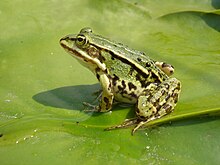Pelophylax kl. esculentus
| Edible frog | |
|---|---|
 |
|
| Scientific classification | |
| Kingdom: | Animalia |
| Phylum: | Chordata |
| Class: | Amphibia |
| Order: | Anura |
| Family: | Ranidae |
| Genus: | Pelophylax |
| Species: | P. lessonae × P. ridibundus |
| Binomial name | |
|
Pelophylax kl. esculentus (Linnaeus, 1758) |
|
| Synonyms | |
|
Pelophylax esculentus (Linnaeus, 1758) |
|
Pelophylax esculentus (Linnaeus, 1758)
Rana esculenta Linnaeus, 1758
The edible frog (Pelophylax kl. esculentus) is a name for a common European frog, also known as the common water frog or green frog (however, this latter term is also used for the North American species Rana clamitans).
It is used for food, particularly in France for the delicacy frog legs. Females are between 5 and 9 cm long, males between 6 and 11 cm.
P. esculentus is endemic to Europe. It naturally occurs from the northern half of France to western Russia, and from Estonia and Denmark to Bulgaria and northern Italy. The edible frog is introduced in Spain and the United Kingdom. The natural range is nearly identical to that of P. lessonae.
Pelophylax kl. esculentus is the fertile hybrid of the pool frog (Pelophylax lessonae) and the marsh frog (Pelophylax ridibundus). It reproduces by hybridogenesis (hemiclonally).
Hybridogenesis implies that during gametogenesis hybrids (of RL genotype) exclude one parental genome (L or R) and produce gametes with an unrecombined genome of the other parental species (R or L, respectively), instead of containing mixed recombined parental genomes. The hybrid populations are usually propagated by mating (backcrosses) with a sympatric parental species - P. lessonae (LL) or P. ridibundus (RR), providing the second, discarded parental genome (L or R respectively). Hybridogenesis is thus a hemiclonal mode of reproduction; half of the genome is transmitted to the next generation clonally, unrecombined (intact); the other half sexually, recombined.
...
Wikipedia

